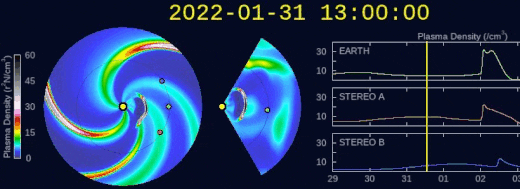Powerful solar flare from recent sun eruption should reach Earth Wednesday
The solar flare could create auroras from the Arctic Circle to New York.

A powerful solar flare has been traveling through space and it will arrive at planet Earth Wednesday (Feb. 2).
In the early hours of Saturday morning (Jan. 30), a coronal mass ejection, a powerful explosion near the sun's surface, erupted into space following an M1-class solar flare. M-class solar flares are medium-size space weather events that can cause temporary radio blackouts on Earth, according to the European Space Agency.
The burst, which came from a sunspot called AR2936, was especially long-lasting, enduring for more than four hours, astronomer Tony Phillips reported at Spaceweather.com.

This outburst is a type of CME known as a "halo CME," which appears larger than the sun in coronagraph images obtained by sungazing spacecraft as the solar particles approach Earth, appearing like a circular halo.
Solar particles from this halo CME will hit Earth starting Wednesday, as anticipated in a forecast model from the National Oceanic and Atmospheric Administration (NOAA), Spaceweather.com reported.
It is possible that, with the CME's arrival at Earth, we could experience a G2-class geomagnetic storm, according to Spaceweather.com. This is a moderate class, "low hazard" geomagnetic storm, a type of event that could spark hours of auroras from the Arctic Circle into northern United States and as far south as New York. These types of events do not interfere with power grids or satellites.
Sign up for the Live Science daily newsletter now
Get the world’s most fascinating discoveries delivered straight to your inbox.
This event is seeing the current solar cycle, which astronomers call Solar Cycle 25, stretch past its expected limits. This 11-year solar cycle has seen more sunspots than predicted and is stronger than experts expected, according to Spaceweather.com. While the solar cycle's peak is difficult to predict, experts have said that the cycle could peak around 2025.
Email Chelsea Gohd at cgohd@space.com or follow her on Twitter @chelsea_gohd. Follow us on Twitter @Spacedotcom and on Facebook.
Chelsea Gohd joined Space.com as an intern in the summer of 2018 and returned as a Staff Writer in 2019. After receiving a B.S. in Public Health, she worked as a science communicator at the American Museum of Natural History. Chelsea has written for publications including Scientific American, Discover Magazine Blog, Astronomy Magazine, Live Science, All That is Interesting, AMNH Microbe Mondays blog, The Daily Targum and Roaring Earth. When not writing, reading or following the latest space and science discoveries, Chelsea is writing music, singing, playing guitar and performing with her band Foxanne (@foxannemusic). You can follow her on Twitter @chelsea_gohd.










